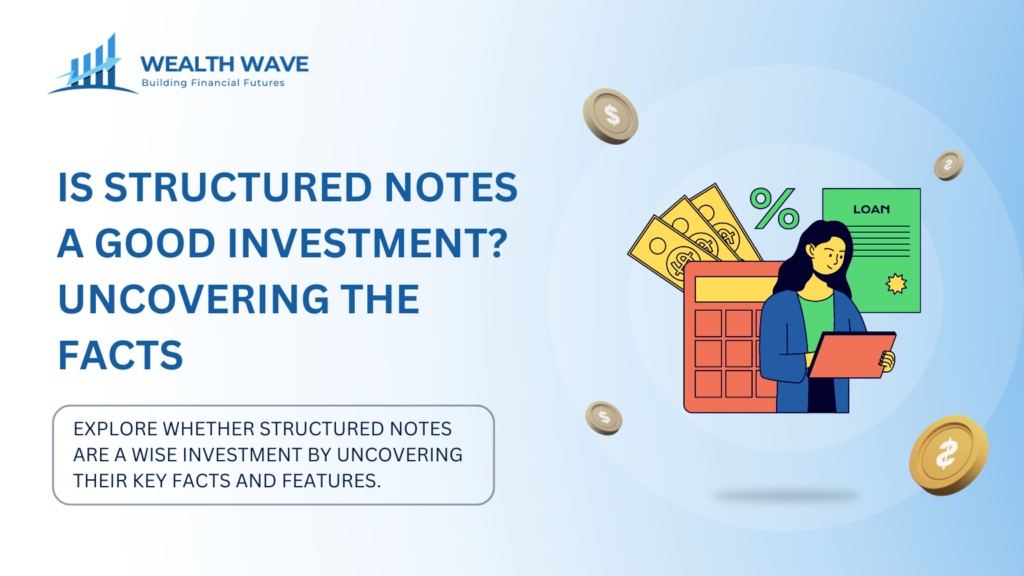
Investing can feel like navigating a maze. We all dream of growing our nest eggs, but with the sea of options out there, zeroing in on the best route feels daunting. Enter structured notes—the financial hybrid that blends debt investments with derivative elements to safeguard your principal while dangling potential market-linked returns.
We’ve walked down this path, flipping through pages and clicking through tabs in search of smart investment strategies that resonate with our aspirations and risk tolerance levels.
Along the way, we stumbled upon structured notes and realized they’re not just another item on the menu; they offer a unique mix of security and growth opportunities. Through this piece, let’s unpack how structured notes function, balance their advantages against their drawbacks, and identify who might benefit from adding them to their portfolio diversification toolkit.
Curious to dive deeper on Is Structured Notes a Good Investment?
Key Takeaways
- Structured notes blend debt investments and derivatives to offer potential market-linked returns while aiming to protect the principal. These instruments can fit initial investment strategies but carry unique risks such as limited liquidity and pricing rigidity.
- Structured notes are a type of debt security, often considered a hybrid security, combining elements of bonds and derivatives. However, structured notes are complicated, as they are tied to the performance of underlying assets like stocks, equity indexes, or other derivatives. The return on a structured note can vary, and while they can provide potential returns, they might also offer early exit options before maturity. Due to their complexity, it’s crucial to consult an investment adviser to fully understand whether a structured note, based on your financial goals, is a good investment.
- Investors choose structured notes for their ability to diversify portfolios by combining different asset classes. They provide growth opportunities linked to various parts of the market or economic performance plus downside protection, although they do not pay fixed interest rates.
- Before investing in structured notes, consider your investment objectives, risk tolerance, current market conditions, and how these products fit into your financial planning. Be aware of fees and complex tax implications that could impact overall returns.
- The Securities and Exchange Commission regulates structured notes, which are a type of debt security and can serve as investment vehicles for retail investors. These notes may offer different features, such as income notes or growth notes, and structured notes with principal protection aim to safeguard the initial investment. However, they are subject to market risk and default risk, and their value can fluctuate in the secondary market. If a structured note matures or an investor decides to exit a structured note before maturity, understanding these risks is crucial. Structured notes can also offer varying degrees of potential return based on their design.
Understanding Structured Notes

Structured notes offer unique investment opportunities. They combine various asset classes to create customized financial products that can fit our investment strategies.
What are Structured Notes?

Structured notes are unique financial products. They are debt obligations with an embedded derivative component. This feature adjusts the security’s risk-return profile. These instruments track the value of another product but do not hold a real underlying portfolio like mutual funds or ETFs.
We can find them often offered by banks, which claim they provide market-linked growth potential along with safety features.
Investors use structured notes to achieve specific objectives in certain market environments. Unlike bonds and CDs, structured notes do not pay fixed interest rates. Their design helps us benefit from stock market performance while offering downside protection.
With their growing popularity, many investors view structured notes as viable investment options for asset diversification and risk management in our portfolios.
Types of Structured Notes

Structured notes come in various types. Each type serves different investment goals and environments. We can find equity-linked structured notes, which tie their performance to stock indices or individual stocks.
These notes often offer market-linked growth potential alongside risk mitigation features.
Another common type is credit-linked structured notes. They are linked to the creditworthiness of specific bond issuers. This connection can provide principal protection while allowing us to benefit from fixed income returns.
Some structured products focus on interest rates, commodities, or foreign currencies as underlying asset classes too. Investors like us choose these based on our investment strategy and risk tolerance.
Understanding these diverse types helps us navigate the options available in structured products better. Next, we will explore the benefits of investing in structured notes.
Benefits of Structured Notes

Structured notes offer several benefits for investors. They allow us to achieve specific objectives in unique market environments. These instruments combine potential returns with downside protection, which can help during times of market volatility.
By offering asset diversification and the opportunity to benefit from stock market performance, structured notes provide a valuable addition to our portfolio solutions.
We find that these debt obligations feature embedded derivatives that adjust their risk-return profile. This flexibility appeals to those focusing on capital preservation or wealth management strategies.
While they don’t pay fixed interest rates like bonds or CDs, structured notes may still fit well within an alternative investments framework, given their growth potential and safety features offered by issuing banks.
Next, we will explore the risks and disadvantages associated with structured notes.
Risks and Disadvantages of Structured Notes

Structured notes come with certain risks that investors should consider. Limited liquidity can make it hard to sell these rest of the investments quickly, while pricing rigidity may not reflect current market conditions.
Limited Liquidity
Limited liquidity presents a challenge for structured notes. Investors cannot quickly sell these instruments like stocks or bonds. This lack of market activity can make it hard to find buyers when we want to cash out.
As a result, we might face longer wait times or unfavorable prices if we need to sell.
Liquidity issues can impact our investment strategy and overall financial planning. We should be aware that structured notes may not suit everyone due to their unique characteristics and risks involved.
Understanding this helps us navigate the complexities of structured note investment performance better, especially as we consider potential benefits in our portfolio diversification efforts.
Pricing Rigidity
Pricing rigidity limits our flexibility with structured notes. These instruments often come with predetermined features that don’t adjust easily to market changes. Unlike stocks, we cannot sell them at any price we choose.
The market for structured notes is not as fluid as others, making it hard to exit a position quickly if needed.
Price adjustments may not reflect current market conditions immediately. This characteristic can affect our returns and overall investment strategy. We need to consider this drawback when deciding if structured notes are a good investment for us, especially since they do not pay a fixed interest rate like bonds or CDs.
As we explore asset protection and diversification in our portfolios, pricing rigidity remains an important factor to evaluate carefully.
Call Risk
Call risk presents a challenge for structured notes. These financial instruments may be called away from us before their maturity date. This happens when the issuer decides to redeem them early, usually due to favorable market conditions.
We lose potential returns when this occurs.
Structured notes are not like traditional bonds that pay fixed interest rates. They rely on market performance for growth potential. If we face call risk, we might miss out on the benefits of stock market gains and downside protection that these investments often offer.
Fees
Fees can significantly impact our returns on structured notes. These investment instruments often carry various costs, such as issuance fees and management charges. These fees typically reduce the overall performance of our investments.
Unlike traditional bonds or CDs, we do not receive a fixed interest rate from structured notes to offset these expenses.
Understanding the fee structure helps us evaluate if structured notes are a good investment for us. Some banks offer lower fees than others, which can affect our decision-making process when selecting these products.
As we consider adding structured notes to our portfolios, we must weigh their potential benefits against the associated costs and ensure they align with our financial goals.
Taxation
Taxation on structured notes can be complex. These investments may not align with our usual expectations of tax treatment like bonds or CDs, which pay fixed interest rates. Instead, structured notes often generate income differently due to their embedded derivative components.
The IRS treats the returns from structured notes as capital gains, which can affect our overall tax burden. Gains might also face taxation at different rates based on how long we hold them.
Understanding these implications is crucial in determining if structured notes are a good investment for us.
How Structured Notes Can Diversify Your Portfolio

Structured notes can add variety to our investment strategy. They mix different asset classes and help us balance risk effectively.
Combining Asset Classes
Combining different asset classes can strengthen our investment strategy. Structured notes allow us to blend investments like stocks with safer options, enhancing our portfolio’s diversity.
These unique instruments offer market-linked growth potential while providing downside protection. By integrating structured notes, we can tailor our approach and manage risks in varying market conditions.
Investing in structured notes helps achieve specific objectives based on how the markets perform. These debt obligations contain embedded derivatives that adjust the risk-return profile without holding an actual underlying portfolio of investments like mutual funds or ETFs.
They have gained popularity recently because they offer a way to benefit from stock market performance while maintaining safety features typically offered by banks.
Managing Risk
Structured notes help us manage risk effectively. They combine different asset classes, allowing us to spread our investments across various markets. This diversification reduces the impact if one asset underperforms.
Structured notes also provide downside protection, which can safeguard our capital during market downturns.
Investing in these instruments requires careful consideration of our risk tolerance and investment goals. They do not pay fixed interest like bonds or CDs but offer growth potential linked to market performance.
Understanding the nuances of structured notes enables us to adjust our portfolios according to changing conditions and better align with our objectives involving buy-and-hold specific investments.
Alternative Investments
Structured notes serve as alternative investments that can fit into our broader financial strategy. These unique instruments allow us to diversify beyond traditional options like stocks or bonds.
They may not hold an actual underlying portfolio of investments, unlike mutual funds or ETFs, but they do track the value of another product.
We see structured notes as a way to benefit from stock market performance while also enjoying some downside protection. Investment banks claim these products offer asset diversification and specific benefits tailored for particular market environments.
Given their growing popularity, we should consider how these alternatives can align with our investment goals and risk tolerance.
Factors to Consider Before Investing in Structured Notes

When we explore structured notes, we must weigh our investment goals, risk tolerance, and current market conditions. Each factor plays a crucial role in shaping our decision. We should also think about how these notes fit into our overall financial strategy.
For more insights on this topic, let’s continue reading together!
Investment Goals
Investment goals play a crucial role in choosing structured notes. We aim to achieve specific outcomes based on our financial strategies. Structured notes can help us target those objectives while adapting to unique market situations.
These instruments allow us to benefit from stock market performance while providing downside protection. However, we must assess whether these investments fit our overall plans.
Our risk tolerance influences how we view structured notes as an investment option. They do not pay fixed interest rates like bonds or CDs, meaning we should align them with our expectations for growth and safety.
Structured notes offer potential diversification but come with risks that could affect our portfolio’s balance over time. Balancing these elements helps us determine if structured notes are a good investment for achieving our goals.
Risk Tolerance
Risk tolerance plays a crucial role in deciding whether structured notes fit our investment strategy. These unique instruments offer market-linked growth potential while carrying specific risks, such as limited liquidity and call risk.
We need to assess how much risk we can handle without losing sleep.
Structured notes do not pay fixed interest rates like bonds or CDs. They often include fees and face taxation challenges that may impact our returns. By understanding our risk tolerance, we ensure our investments align with our goals.
This way, we determine if structured notes are a good investment advice for us amid the complexities of the market.
Market Conditions
Market conditions significantly impact our investment strategy with structured notes. These unique instruments typically respond to movements in the stock market. They offer market-linked growth potential and safety features that can align with current economic trends.
Recent years have shown an increase in their popularity as investors seek alternatives.
Structured notes do not pay a fixed interest rate like bonds or CDs, which makes them sensitive to changing market dynamics. We must always consider how these conditions may affect our specific objectives before investing in structured notes.
Understanding the current environment helps us determine whether this is a good investment for us or if we should explore other options, such as buy-and-hold investments.
Financial Planning
Financial planning plays a crucial role in our investment portfolio. Structured notes can fit within various strategies, depending on our goals and risk tolerance. We should evaluate how these instruments align with our overall financial objectives.
They are unique investments that do not provide fixed interest like bonds or CDs.
Structured notes often come with fees that can impact returns. Understanding the costs is vital for effective planning. As we consider structured notes, we must weigh their potential benefits against their risks and price rigidity.
These factors help us determine if they support our long-term vision of creating wealth through diversified investment products like structured notes or buy-and-hold approaches.
Conclusion (Is Structured Notes a Good Investment?)

We have explored structured notes and their unique features. These financial instruments can provide diversification and growth potential. Yet, they also come with certain risks that we cannot overlook.
Understanding our investment goals is essential before diving into structured notes. We recommend seeking advice or additional resources to enhance our knowledge on this topic. Taking informed steps can lead us toward better investment decisions.
FAQs
Q1. What are structured notes as an investment?
Ans. Structured notes are a type of buy-and-hold investments where the return is linked to the performance of a specific asset.
Q2. Are structured notes a good choice for my portfolio?
Ans. Whether structured notes make a good investment depends on your risk tolerance and financial goals. They can offer higher returns, but they also carry more risk than traditional bonds.
Q3. What factors should I consider before investing in structured notes?
Ans. Before you invest, it's important to understand how these complex products work, their potential risks and rewards, and whether they align with your overall investment strategy.
Q4. Can I lose money by investing in structured notes?
Ans. Yes, like all investments, there's always the possibility of losing money when you invest in structured notes if the underlying asset performs poorly.




